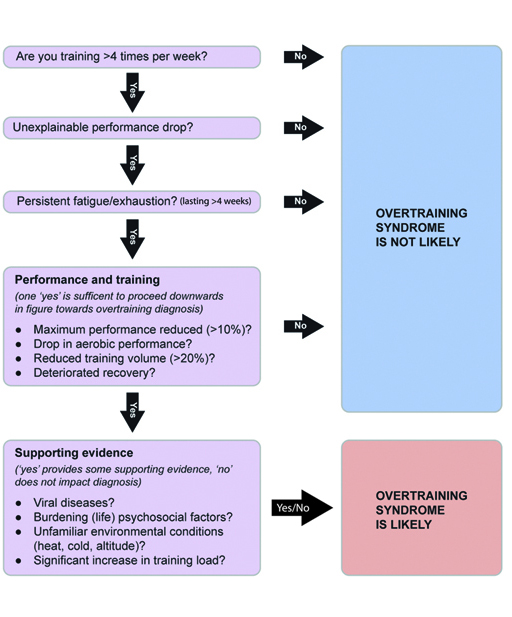5 Insight: a medical assessment
Such has been the concern about overtraining that in 2013 the European College of Sport Science (ECSS) and the American College of Sports Medicine (ACSM) took the unusual step of issuing a position statement on overtraining (Meeusen et al., 2013).
Using this consensus of expert opinion, they developed a diagnoses flowchart for assessing if athletes are overtrained.
Activity 4 Have you ever been overtrained?
The following eleven criteria are recommended by ECSS/ACSM to clinicians to help them assess the classification of athletes who are experiencing the overtraining syndrome (Figure 3).
Review the eleven ‘yes’/ ‘no’ criteria. Then think of a time when there was an imbalance in your stress–recovery. The flowchart starts with the key symptoms such as decrease in performance and duration of symptoms; then performance changes are defined and possible supporting evidence identified. A challenge is that there are ‘confounding conditions’ which get in the way of accurately assessing overtraining (e.g. illnesses or infections). Using your example, work downwards through each of the diagnostic questions in turn, following the flowchart options. Are you suffering from overtraining syndrome? Which of these criteria, if any, surprised you?
ECSS/ACSM states that overtraining may involve ‘several confounding factors such as inadequate nutrition (energy and/or carbohydrate intake), illness (most commonly, upper respiratory tract infections), psychosocial stressors (work, team, coach, and family related), and sleep disorders’.
Discussion
The criteria suggest that you need to be training at least five times a week and to have been exhausted for at least four weeks. These seem quite rigid criteria. The term ‘deteriorated recovery’ seems vague and it is not clear to what extent sleep disturbances are included as part of this.
The environmental conditions of heat (hot or cold) and altitude are new criteria not mentioned previously; this suggests that training in such environments may be a trigger factor due to the increased physiological stress this would create. The inclusion of ‘burdening [life] psycho social factors’ demonstrates that this condition may not solely be triggered by physical factors.
Professional judgement is needed to help make difficult decisions about how to respond to those athletes with some, but not all, of these symptoms. However, prevention is better than cure, and technology can be used to monitor athletes. Next you will look at a monitoring tool used by the English Institute of Sport and consider whether use of this is surveillance or support.

